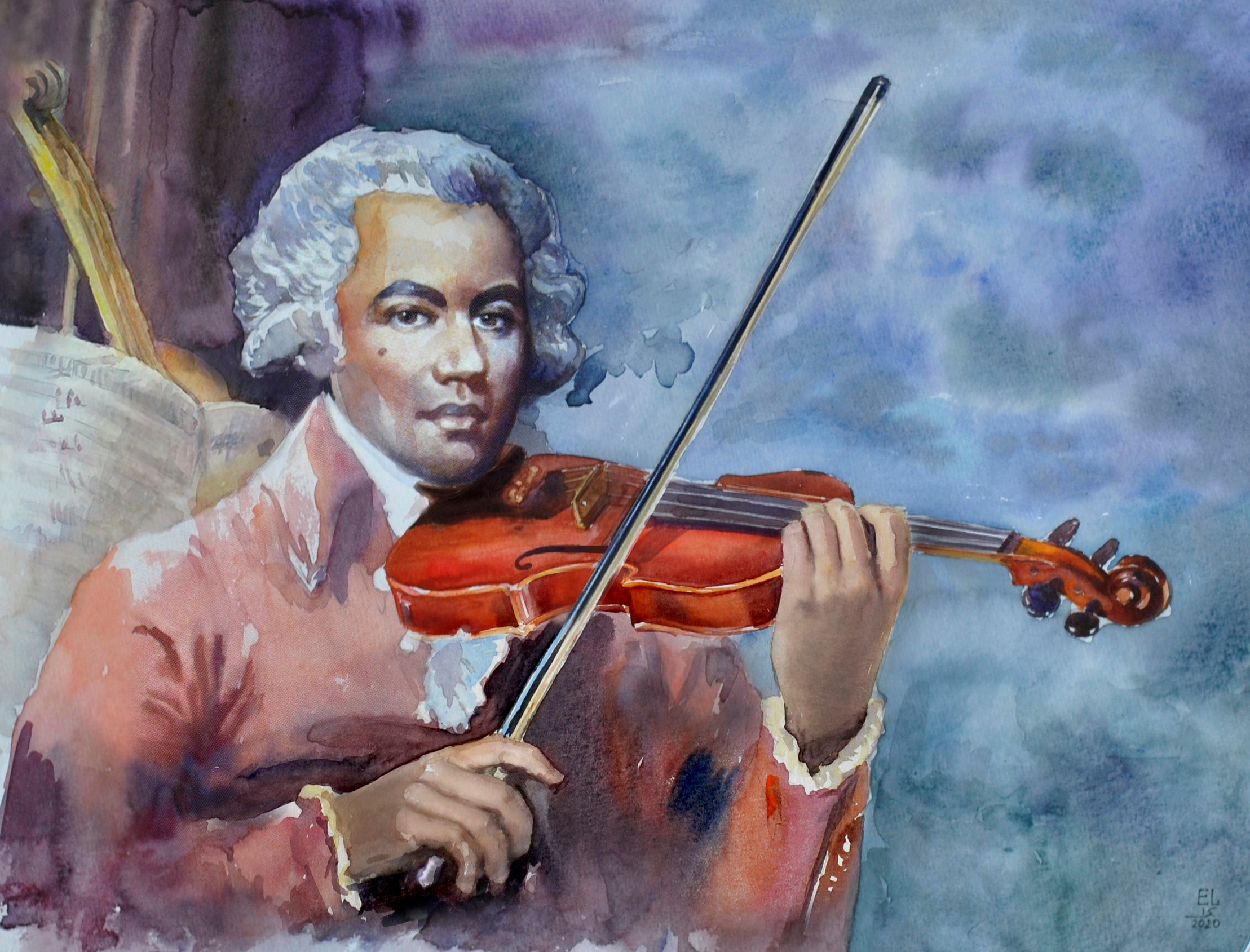Home
Blog
Composers
Musicians
Black History
Audio
About Us
Links
Saint-Georges Sub-pages:
Gian Faldoni
Violin Concertos
Symphonies
String Quartets
Harpsichord Sonatas
Composers:
Adams, H. Leslie
Akpabot, Samuel Ekpe
Alberga, Eleanor
Bonds, Margaret Allison
Brouwer, Leo
Burleigh, Henry Thacker
Coleridge-Taylor, Samuel
Cunningham, Arthur
Dawson, William Levi
Dede, Edmund
Dett, R. Nathaniel
Elie, Justin
Ellington, Edward K. "Duke"
Euba, Akin
Garcia, José Mauricio Nunes
Hailstork, Adolphus C.
Holland, Justin
Jeanty, Occide
Johnson, James Price
Joplin, Scott
Kay, Ulysses Simpson
Khumalo, Mzilikazi
Lambert, Charles Lucien, Sr.
Lambert, Lucien-Leon G., Jr.
Lamothe, Ludovic
Leon, Tania
Moerane, Michael Mosoeu
Perkinson, Coleridge-Taylor
Pradel, Alain Pierre
Price, Florence Beatrice Smith
Racine, Julio
Roldan, Amadeo
Saint-Georges, Le Chevalier de
Sancho, Ignatius
Smith, Hale
Smith, Irene Britton
Sowande, Fela
Still, William Grant
Walker, George Theophilus
White, José Silvestre
Williams. Julius Penson
Guest Book
William J. Zick, Webmaster
wzick@ameritech.net
©
Copyright 2006-2022
William J. Zick
All rights reserved for all content of AfriClassical.com
Some Sites Selling Saint-Georges CDs:
Amazon.com www.amazon.com
Arkiv Music www.arkivmusic.com
CBC www.cbc.ca
Cedille
www.cedillerecords.org
Crotchet www.crotchet.co.uk
H&B Recordings Direct
www.hbdirect.com
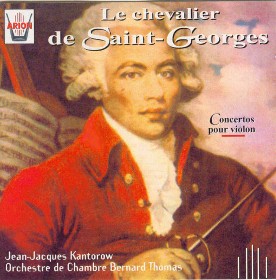
Violin Concertos, Op. 5, Nos. 1 & 2;
Op. 3, No. 1; Op. 8, No. 9
Bernard Thomas Chamber Orchestra
Jean-Jacques Kantorow, Violin
Arion 68093 (1990)
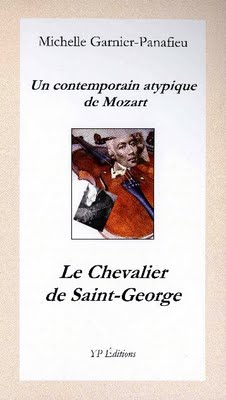
Un contemporain atypique de Mozart
: Le Chevalier de Saint-George
Michelle Garnier-Panafieu
YP Éditions (2011)
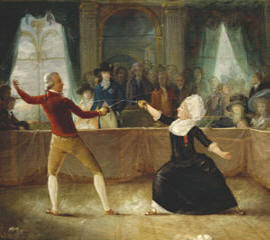
"The
assault or fencing match which took place between Mademoiselle la
Chevalière d'Eon de Beaumont and Monsieur de Saint-George on the 9th
of April 1787 - At Carlton House in the presence of the Nobility and
many eminent Fencing Masters of London." The Royal Collection © 2010,
Her Majesty Queen Elizabeth II.
(Paragraph 30 on this page provides background on the event.)
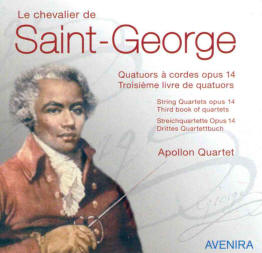
String Quartets Opus 14; Third Book of Quartets
Apollon Quartet
Avenira 276011 (2005)
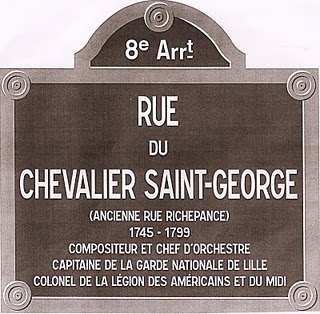
Rue du Chevalier Saint-George
(Chevalier de
Saint-George Street)
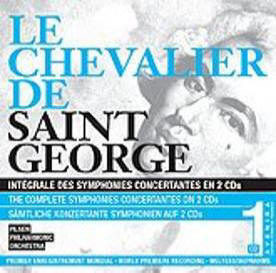
The Complete Symphonies Concertantes, CD1
Miroslav Vilimec & Jiri Zilak, violins
Pilsen Philharmonic Orchestra/
Jiri Malat, conductor
Jiri Zilak & Michal Pospisil, violins
Pilsen Philhamonic Orchestra/
Frantisek Preisler, Jr.,
conductor
Avenira 276017 (2008)

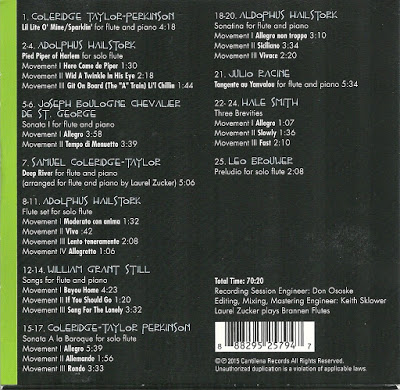
|
Home ->
Composers -> Saint-Georges, Le
Chevalier de
Français
Un contemporain atypique de Mozart (An Atypical
Contemporary of Mozart): Le Chevalier de Saint-George is
a scholarly book by Prof. Michelle Garnier-Panafieu, who
formally presented her book in public for the first time
at The
International Saint-Georges Festival in Guadeloupe on
April 27, 2011. Prof. Garnier-Panafieu has
graciously provided AfriClassical.com with a summary of
the book for the Saint-Georges Biography page.
(See No. 52 in the Table of Contents.)
Audio Samples:
1 AFKA SK-557 (2003); Chevalier de Saint-
Georges: String Quartets; Coleridge String
Quartet
String Quartet No. 3 in C Major
(Sample Time
5:03)
2 Cedille 90000 035 (1997);
Violin Concertos By
Black
Composers of the 18th & 19th Centuries;
Rachel Barton, violin;
Encore
Chamber Orchestra; Daniel Hege, Conductor
Violin
Concerto in A Major, Op. 5, No. 2
For additional
samples, see the Audio page or the pages on
Saint-George's Violin Concertos, Symphonies and String
Quartets.
1 Overview
Joseph de Bologne,
the Chevalier de Saint-Georges, was one of the most
remarkable figures of the 18th century. Incredibly,
this son of a slave rose to the top of French society
through his mastery of fencing and his genius for
classical music! His dual career is illustrated in the
above portrait. He is dressed for a concert but holds a
sword in place of a conductor's baton. The painting was
done in London in 1787 by the American artist Mather
Brown.
2 CDs
Links at upper left
lead to selected CD titles, liner notes and audio
samples in four categories: Violin Concertos,
Symphonies, String Quartets and Harpsichord Sonatas. The
Violin Concertos include Monsieur de Saint-George: 4
Concertos pour violon (4 Concertos for Violin),
Calliope 9373 (2007) by Les Archets de Paris. Among the Symphonies is the sound track to the
DVD Le Mozart Noir. CDs by the Antarès, Apollon,
Coleridge and Jean-Noel Molard String Quartets are
featured. Anne Robert's recent CD Les 10 sonates pour
clavecin (10 Sonatas for Harpsichord) is
among the discs for her instrument.
3 Biography
This essay relies
mainly on four biographies: (1) Joseph Boulogne
called Chevalier de Saint-Georges (1996) by Emil F.
Smidak in English and French; (2) The Chevalier de
Saint-Georges: Virtuoso of the Sword and the Bow
(2006)
by Gabriel Banat; (3)
Le chevalier de Saint-George (2004)
by Claude Ribbe in
French; and (4) Joseph de Saint-George, le
Chevalier Noir (The
Black Chevalier)
(2006) by Pierre Bardin.
4 Annals of History
The
authoritative source on birth records is Luc Nemeth,
Professor of Contemporary History, writing in the
Annales Historiques de la Révolution Francaise [Historic
Annals of the French Revolution], No. 339,
January, 2005, pp. 79-97. Here is an excerpt:
|
The gaps in the old
records of the parish archives of Bailliff (Guadeloupe),
and the illegitimate birth of Saint-George, the natural
child of a slave, partially explain the confusion which
was able to envelop his public records: three different
dates of birth have been able to be attributed to him,
not without some basis for each. |
The author notes that the
identity of Saint-Georges' father was proven in 1972 by Odet Denys.
5 Birth
Joseph de Bologne's father was George de Bologne de
Saint-Georges, a member of a wealthy family which had lived
in the French West Indies colony of Guadeloupe since 1645. He
married Élisabeth Merican on September 8, 1739. By January, 1740
he had moved to a 250-acre plantation with 60 slaves. One of the
slaves was an attractive young woman about 17 who was named Anne
but was called Nanon. She was of African descent and was born on
the island. George and Nanon began an intimate relationship
shortly after his arrival. Their son Joseph de Bologne came into
the world on Christmas Day, 1745. His African heritage made him
ineligible for the nobility and its titles under French law.
6 Fugitive
George de Bologne soon found himself a fugitive. On December
17, 1747 he fatally wounded a man in a fencing duel caused by a
drunken quarrel. He fled Guadeloupe secretly the following month
to avoid a charge of homicide. In spite of his absence he was
sentenced to death on March 31, 1748 and his goods were ordered
confiscated. Surprisingly, his wife Élisabeth was given
permission on September 1, 1748 to leave the island with Joseph
and Nanon. Joseph turned 3 at sea and arrived in France on
January 4, 1749. The Bologne family used its influence with the
royal court to secure a pardon for George from King Louis XV. Joseph and his parents sailed from Bordeaux, France on September
2, 1749. The ship's manifest said George was 38, Nanon was 26
and Joseph was 3 years old.
7 Childhood
Young Joseph lived a
privileged life on the plantation. He had ample time to play,
and his father gave him lessons in music and fencing. When he
was 8 years old, Joseph sailed for Bordeaux with Élisabeth to
start school, arriving on August 12, 1753. Nanon landed at the
same port on September 10, 1754 and visited Joseph for several
weeks. Nanon and George arrived back in France on September 10,
1755. They took Joseph to live with them in the fashionable
Saint-Germain quarter of Paris. On April 1, 1757, Pierre Bardin
tells us, George obtained the position of Gentleman of the
King's Chamber, which meant he was a personal assistant to King
Louis XV.
8 Fencing Academy
Joseph's life changed radically the following year. In October,
1756 the 13-year-old entered the fencing academy of Nicolas
Texier de La Böessière, an elite boarding school for the sons of
the aristocracy. Mornings at the academy consisted of classes in
mathematics, history, foreign languages, music, drawing and
dance. Afternoons were devoted to the most important subject,
fencing. Joseph trained alongside the son of La Böessière and
became a friend of the family. The younger La Böessière later
wrote that Saint-Georges was the most extraordinary man of arms
ever seen. Training in horsemanship took place at the Tuileries
under expert guidance.
9 Écuyer
Pierre
Bardin writes that on May 10, 1763, Joseph de Bologne purchased
“L'Office d'Écuyer, Conseiller du Roy, controlleur ordinaire des
guerres” or “The Office of Cavalier, Adviser to the King,
Controller Ordinary of Wars”. It made him an
Officer of the public ministry
to carry the orders of the King to the War Tribunal. The author
continues:
|
Joseph de
Saint-George is thus
"Controller
Ordinary of Wars",
with the title of
"Écuyer".
He would remain in the position for 11 years and could
take the title of chevalier, as he had the right. This
was not a title of fantasy. This office allows one to
understand why, come the Revolution, one would entrust
to him the command of a regiment of light cavalry, and
not only for his skill as a swordsman, but because in
the field of management of this type of organization, he
had acquired the necessary skills... |
The minimum age for the office
was 25, and Joseph was only 17, but a waiver was granted, we
learn from Bardin. We learn from Prof. Luc Nemeth that
Joseph officially obtained the position of Officer of the King's
Guard on June 15, 1764 and not in 1761 as stated by several
biographers of Saint-Georges. He served only 3 months per year,
so his education continued without interruption.
10 Registration of Blacks
The
increasing presence of people of color in France resulted in the
rise of government efforts to limit and regulate their
immigration. The Enlightenment philosopher Voltaire was among
those who argued that Africans and their descendants were
genetically inferior to White Europeans. More influential on
the King were the demands of slave owners and traders to
maintain racial separation in order to protect their businesses.
A Code Noir [Law of Blacks] had been on the books since the 17th
century. On April 5, 1762 King Louis XV decreed that Nègres et
gens de couleur [Blacks and people of color] must register with
the clerk of the Admiralty within two months. Nanon registered
herself; La Böessière registered Joseph. We learn from Pierre
Bardin that « Anne Nanon » was 34 at the time of registration on
May 10, 1762. Gabriel Banat reports that the total number of
persons registered in Paris under the decree was 159.
11 Black
Parisians
Pierre Bardin describes how Saint-Georges and a small number of
other people of color overcame the barrier of racism and entered
the middle class:
|
It is undeniable that
he was gifted, but his inborn talents were magnified by
relentless effort, permitting him not only to be better,
but above all to overcome the racial barrier which put
him in the disdained social class of "Mûlatres" ("Mulattos")
because his father was White and his mother was Black.
|
Bardin
finds historical evidence of a diverse population of people of
color in Paris during the era. He says few people of
African descent were in the city's middle class:
|
Rare are those who are described as members of "the
middle class of Paris" such as André Lucidor, a former
slave who became a master of arms and had a fencing hall
on rue de Ménilmontant. |
The
author reports Lucidor declared himself to be an African who was
a slave in Martinique before arriving in France, where he was
emancipated in 1750. Interracial marriage was officially
prohibited, but Bardin says Lucidor was just one of a number of
people who married in defiance of the ban.
12 Father's Will
George
de Bologne de Saint-Georges made a Last Will and Testament on
December 9, 1765, we learn from Pierre Bardin. His biography
includes the complete text, including this excerpt:
|
I give and bequeath to Mademoiselle Anne Nanon, a free
Negro woman who has been in my service for 30 years, a
sum of three thousand pounds. I also give and bequeath
to Monsieur de Saint-George, Écuyer,
Adviser to the King and Controller Ordinary of Wars, a
sum of fifty thousand pounds. |
|
13 Fencer
Joseph studied at the fencing academy for 6 years, until he was
19. By that time everyone called him Le Chevalier de
Saint-Georges. Several excerpts from Claude Ribbe's book have
been translated from French by the Webmaster. This is the first:
|
Whether or not his use of the title was legal,
this Chevalier was in any case inimitable. He
excelled at everything he did. His budding
reputation led him, in spite of himself, to link
his exploits. At age 17 Joseph was not only
an accomplished athlete but already a public
figure. Known and recognized, he practiced,
with a disconcerting superiority, all of the
artistic and athletic disciplines in which the
young aristocrats chose to do no more than
they had to.
Was Joseph's body astonishing? It was more
surprising when the American showed he
knew how to use it.
With a consummate sense of provocation, the
young man made of this problematic body,
which the readers of Voltaire were supposed
to regard as a degenerate product, the
instrument of his glory. He transformed it into
an admirable object to which, however, he
refused to reduce himself. Because it was not
the body of Joseph which was in command, it
was Joseph himself. He subjugated his own
flesh as easily as he knew how to control the
most skittish horses.
...
The sword being reserved to the nobility, the apprenticeship of arms, heavily regulated to
exclude undesirable students and masters,
belonged to the elite. To figure among this
aristocracy, and in first place yet, was no
small thing. By his preeminence in fencing,
Saint-George acquired a position of
invulnerability which was both physical and
social. |
Saint-Georges had become known in the world of fencing as
"the god
of arms".
14 Athlete
Emil F. Smidak is the author of Joseph Boulogne called Chevalier
de Saint-Georges. He writes of Saint-Georges:
|
He could often be seen swimming across the
Seine with only one arm, and in skating his skill exceeded everyone else's. As to the
pistol, he rarely missed the target. In running
he was reputed to be one of the leading
exponents in the whole of Europe. |
In addition to his skills as an athlete, Saint-Georges was also an
excellent dancer.
15 Picard & Faldoni
When Saint-Georges was 19 his father offered him a fine English
horse and a fashionable 2-wheel cart if he could defeat Picard,
a skilled fencing master at Rouen. Saint-Georges won the match
and was soon riding in style on the streets of Paris. In the
following year Gian Faldoni, a famous Italian, came to Paris to
challenge Saint-Georges. He refused at first, but after Faldoni
defeated every other prominent fencer in the city he finally
agreed. The match was a public spectacle attended by the royal
court. The opponents were of comparable skill; they fought long
and hard. Each took a turn in the lead but ultimately Faldoni
won, 4 touchés to 2. It was the first defeat in his remarkable
career, and Saint-Georges took it hard.
16 Le Concert des amateurs
Saint-Georges had mastered both the harpsichord and the violin. Successful composers who dedicated works to him included Antonio
Lolli (1764), François-Joseph Gossec (1766) and Carl Stamitz
(1770). The latter addressed him in Italian by his full
official title. It is believed
that he had been tutored in violin by Jean-Marie Leclair,
another important composer of the time, and had studied
composition with Gossec. He is believed to have become the
first violin, or concertmaster, of the ensemble by 1771, Gabriel
Banat writes. Gossec was the orchestra's founder and
Conductor. Professor Ribbe gives
this description of the orchestra:
|
The ensemble, in which amateurs sat beside
professionals from the King's Royal Academy
and from the King's Music, consisted of more
than 70 performers, with 40 violins and violas,
12 cellos, and 8 double basses, to which were
to be added the winds: flutes, oboes,
clarinets, trumpets, horns and bassoon. |
17 Violinist & Composer
Saint-Georges composed a Sonata for Flute and Harp. Subsequently,
he and Gossec were among the earliest French composers of string
quartets, symphonies concertantes, and quartets concertantes. His
first string quartets were performed in the salons of Paris in
1772. They were published in the spring of 1773. Claude Ribbe
recounts:
|
During the 1772-1773 concert season, Joseph
directed and played his first two violin
concertos at the Amateurs. Le Mercure [The
Mercury] reported that they 'received the
greatest applause as much for the quality of
playing as for that of the composition'. |
In the liner notes for the Arion CD 55445 (1999) violinist Joel
Marie Fauquet writes:
|
...Saint-Georges acquired the mastery over his
technique and sonority early on, to an extent
that 'his velvety talent on the violin sometimes
gave him preference over the cleverest artists
of his day'. |
18 Conductor
Saint-Georges became Conductor of Le Concert des amateurs in 1773,
combining his duties with composing. From 1773-1775, he produced
8 violin concertos and 2 symphonies concertantes, according to
the Works List compiled by Gabriel Banat. In
1775, only two years after Saint-Georges became Conductor,
L'Almanach Musical [The Musical Almanac] wrote that the ensemble
was "the best orchestra for symphonies in Paris and perhaps in
Europe".
19 Paris Opera
Biographer Gabriel Banat explains that bids to manage the Paris
Opera were solicited, and one was submitted by a company
headed by Saint-Georges. He quotes the January 1776 issue of Baron Grimm's review of
Parisian life, the Correspondance, on the point, and adds
this excerpt:
|
No
sooner were Mesdemoiselles Arnould, Guimard, Rosalie,
and others informed about the news [that Saint-Georges
had
been proposed as music director of the Opéra], they
presented a placet [petition] to the Queen, assuring her
Majesty that “their honor and their delicate conscience
could never allow them to submit to the orders of a
mulatto.” Such an important consideration makes all the
impression it is expected to make, but, after many
projects and discussions regarding the matter, the
question has been decided by the king, who in the end
took it upon himself to have the Opéra managed on his
behalf by the Intendants and Treasurers of the Menus
Plaisirs [the king's light entertainments]. |
20 Intrigue
Gabriel Banat asks if race was the true motive of the protesters
who submitted the petition to the Queen:
|
That
so-called placet put an end to any aspirations
Saint-Georges may have had of becoming music director of
that great institution, the most prestigious musical
post in France. This was, as far as we know, the most
serious setback yet he had suffered because of his color.
But was it really about that? |
Banat writes
that Saint-Georges had proposed a reorganization, causing Arnauld
and Rosalie to fear dismissal. He adds that the victorious
Intendant of light entertainment, Papillon de La Ferté, was the
lover of Guimard:
|
Indeed,
each member of the cabal would
benefit from the intrigue. The singers, fearing
dismissal, were reassured that the status quo would
prevail; La Guimard, through her lover, would have
virtually a free hand at the Opéra; and Papillon would
wield greater power than he had ever dreamed of in the
good old days before Louis, the frugal, mounted the
throne. |
21 Don Juan Noir
Much has been made of Saint-Georges' reputation as a Don Juan
Noir [Black Don Juan]. Professor Ribbe traces such talk to a
jealous remark of Bachaumont:
|
In attributing seduction by Saint-George to
neither his handsomeness nor his personal
qualities but to his 'marvelous talents', in other
words to his sexual performance, Bachaumont
embellished upon a recurrent racist fantasy
which attributes to Africans and their
descendants an anatomy in proportion to their temperament; that is to say their supposed
bestial sexuality. |
Saint-Georges did have at least one serious romantic
relationship, but racial attitudes made it impossible for him to
marry anyone at his level of society.
22 Musical Theater
Although rejected for the post at the Paris Opera, Saint-Georges
was later appointed music director of the private theater of the
Marquise de Montesson. He directed 2 to 3 performances each
week. He also served as Lieutenant of the Hunt for her husband,
Louis Philippe, Duke of Orléans. The composer's first musical
comedy was a 3-act work, Ernestine, for which he wrote only the
music. It was performed at the Comédie-Italienne on July
19, 1777. The music was
given generally good reviews, but the press panned the
work for
its lyrics.
23 Professional Peak
Professor Ribbe writes that by 1778 Saint-Georges had reached his
professional peak as a composer. He published 2 symphony
concertantes in 1776 and 2 more in 1778. In 1777 he wrote
3 violin concertos and 6 string quartets.
Some people call Saint-Georges the Black Mozart, but that
nickname is not accurate, according to Dominique-René de Lerma,
a specialist in the works of Saint-Georges and a Professor of
Music at Lawrence University in Appleton, Wisconsin. Saint-Georges was always much more than
a figure in classical music. He was one of the best fencers in
Europe and a heroic Colonel in the French Revolution. Saint-Georges wrote the music for a second musical comedy,
La
Chasse [The Hunt], first performed on October 12, 1778. It was a
big hit with the audience and was unanimously praised by the
press.
24
Music of the Queen
Gabriel Banat reports that music was an important part of
Marie-Antoniette's childhood at the Vienna Hofburg:
|
There,
along with her brothers and sisters, Marie Antoniette
had daily instruction in voice, harp, and forte-piano,
the last provided by the renowned Bavarian composer,
Christoph Willibald Gluck. With a fine singing
voice and the ability to read notes at first sight, she
acquired an understanding of and genuine enthusiasm for
serious music. As a result, she became the first
royal hostess at Versailles since Marie de Medici, who
not only appreciated music but was also able to
participate in its performance. |
Early in 1779,
Saint-Georges began performing music with Queen Marie-Antoniette
at Versailles, at her request. Professor Ribbe notes that some
people in the palace were unhappy about the arrangement.
25 Midnight Ambush
One night that
spring, Pierre Bardin writes, Saint-Georges and Baron Gillier were walking alone
in Paris on the Boulevard du Temple at 12:30 A.M. when they were attacked.
He describes the incident on the basis of the files of the Police Chief in Châtelet:
|
...they are
attacked, and him in particular, by eight or ten
individuals obeying the orders of Sieur Des Brugnières.
One of them strikes him a violent blow of the stick on
the arm, causing a strong contusion. Saint-Georges then
seizes his sword, knocks the attacker's stick away and
grabs him by the collar. A general brawl
follows...
|
|
Pierre Bardin
says
Saint-Georges
receives the assistance of a friend, Louis de Lespinasse
Langeac, who lives in
the vicinity.
26 Police Inspector
The author's account continues with the arrival on the scene of
a Police Inspector:
|
At this point
there appears a uniformed Police Inspector of the
Gendarmerie of France.
Saint-George,
respectful and without mistrust, gives up his sword, but
at this time, Des Brugnières puts a gun to him on the
throat while saying to his men "de le ganter", i.e. to "tie
his hands".
Saint-George asks to be led to the commander of the
watch, which is done, but the latter sends him to the
Police Chief. |
Des Brugnières was able to clear himself
with the aid of the Police Inspector, Bardin explains,
by claiming he had not held the pistol to the
neck of Saint-Georges,
but had merely displayed it after being insulted
and menaced with a sword. The matter went no further, we are
told.
27 Mistaken Identity
Pierre Bardin says it is likely the attack was revenge by a
husband who wrongly suspected Saint-Georges of fathering his
wife's child. He writes:
|
...there was
undoubtedly an error in identification of the person. |
The author notes that in 1781,
Louis de Lespinasse Langeac signed an agreement to make annual
support payments to the woman and her child.
It was obvious that someone
in power had ordered his murder, so Saint-Georges began taking
precautions to avoid further incidents. For example, he chose
Mme. Montesson's private theater for the premiere of L'Amant
anonyme [The Anonymous Lover] in March, 1780. He had also
published 2 more symphonies by then.
28 Olympic Lodge Orchestra
The Chevalier was one of the first Black Masons in France. He
was initiated into a Parisian lodge of the Grand Orient of
France called Les 9 Soeurs [The Nine Sisters]. The Concert des
amateurs closed in early 1781, and Masons quickly founded a new
orchestra, Le Concert de la Loge Olympique [The Olympic Lodge
Orchestra]. It was sponsored by a lodge known as l'Olympique de
la Parfait Union [The Olympic of the Perfect Union]. The
musicians were all Masons and were as skilled as those of the
Amateurs. They performed in elegant quarters in the Palais-Royal
[Royal Palace] under the direction of Saint-Georges. In
1784 he was authorized to commission Franz Joseph Haydn to write
6 symphonies for publication in Paris.
29
Clarinet Concerto
According to The Musical Almanac, Pierre Bardin writes,
Saint-Georges composed a clarinet concerto which was premiered
by the renowned clarinetist Antonio Soler and the Concert
Spirituel at the Château
Tuileries
on March 25, 1782.
Bardin
continues:
|
Thus
the concerto precedes that of Mozart. A rather
exceptional fact for the period, where a work was often
played only one time, this concerto was registered in
the repertoire of the Spirituel and was played four
times between March and April, then reprised February 2
and April 15, 1783, with the same Soler, the soloist let
us recall it, of the Olympic
Lodge. |
30 La chevalière d'Éon
The Prince of
Wales arranged a friendly fencing demonstration in London
between Saint-Georges, who was 42, and a 59-year-old French
woman, La chevalière d'Éon. Saint-Georges had broken an
Achilles tendon at age 40, and was not as nimble as before. He
could still parry and counterattack effectively. Gabriel Banat
writes that on April 9, 1787 Saint-Georges was hit once by his
opponent but still won the match. Pierre Bardin explains
that La Chevalière hit Saint-Georges with what he calls a “coup
de temps” which might be translated into English as a “time
hit” or “counter time”.
This action involves hitting one’s
opponent on the preparation of his attack, thus reaching the
target first. The chevalière
was actually Charles d'Éon de Beaumont, a diplomat who dressed
as a woman for many years to help him spy on foreign countries
for the King of France. D'Éon was a multitalented man of
letters, law, diplomacy and the military but had fallen out of
favor with the royal court. He practiced fencing daily, in fear
of his life. The encounter was not treated as headline news in
the newspapers of Paris, but in her memoirs the Marquise de
Créquy
decried the
fencing match between a
"French
gentleman"
and a "mulatto"
in scornful and racist language.
31 Voltaire's Influence
Four months after the fencing match in London, Saint-Georges
premiered La Fille Garçon [The Girl Boy] at the
Comédie-Italienne. Once again, most of the press praised the
music of Saint-Georges. Baron Melchior von Grimm's newsletter on
Parisian culture was an exception. Professor Ribbe notes that
its critique reflected the racist opinions of Voltaire. He
begins by paraphrasing the review:
|
Certainly, the Chevalier was capable of playing
the violin, but he was not creative. It would be
contrary to Nature if he were. In the rest of his
review Grimm showed that he had retained the
lesson of Voltaire well: 'This piece, he said, is
the best Monsieur de Saint-George has ever
written. Nevertheless, it also appears to be
lacking in creativity. This recalls an
observation, which has not yet been
contradicted, that if Nature has served the
mulattos well in a certain way by giving them
a marvelous aptitude to practice all the
imitative arts, it seems however to have
refused this impulse of feeling and genius
which alone produces new ideas and original
designs.' |
The author points out that the term mulatto was as demeaning and
insulting in the 18th century as it is today.
32 Paris Symphonies
Saint-Georges and the Concert de la Loge Olympique premiered
Haydn's 6 Paris Symphonies, Nos. 82-87, in a triumphant series
of concerts in 1787. Queen Marie-Antoniette attended them. Symphony No. 85
is called The Queen because it was Her Majesty's
favorite.
33 Friends of Black People
Saint-Georges' trips to England introduced him to the country's
anti-slavery movement. He helped found a French group called the Société des amis des noirs [Society of the Friends of Black
People]. He also produced a children's musical, Aline et Dupré
ou Le Marchand des marrons [Aline and Dupré or The Chestnut
Seller]. It was staged on August 9, 1788. As a violinist,
Saint-Georges gave concerts in England as well as France. One
dark evening in January 1790 on which he was scheduled to
perform in England he was walking alone, carrying his violin,
when a man with a pistol and a stick tried to rob him. He fought
off the robber, only to be attacked by 4 more men. He
overpowered them as well. Gabriel Banat argues that
Saint-Georges' support for the liberation of slaves was known in
England, “...and no doubt sufficiently irritating to Britain's
slave cartel to make them try to eliminate him.”
34 French Revolution
Saint-Georges was living in Lille when the French Revolution
broke out in July, 1789. He joined the National Guard in Lille
later that year. He obtained the rank of Captain in 1790. Saint-Georges the soldier was still a musician and a fencer, so
he organized concerts and fencing demonstrations in Lille while
stationed in the city. He even wrote an opera,
Guillaume-Tout-Coeur ou les Amis de village [William-All-Heart
or The Village Friends]. An actor from Lille wrote the lyrics
for the work, which was performed September 8, 1790. Saint-Georges' connections with the Ancien Régime now made him
the object of great suspicion, so he began signing his name as
either Saint-George or simply George.
35 Saint-George Legion
Members of the National Guard were asked to volunteer for active
duty, so Saint-Georges enlisted on June 21, 1791 as an
aide-de-camp to two generals. He soon received another call to
duty. On September 1, 1791 a delegation of men of color, led by Julien Raimond of Saint-Domingue, asked the National Assembly to
allow them to fight in defense of the Revolution and its
egalitarian ideals. The next day, the Assembly approved a corps
comprised mainly of men of color, with 800 infantry and 200
cavalry personnel. Saint-Georges was appointed to be its Colonel. Its official name was légion franche de cavalerie des
Américains, but it soon became known to all as the légion
Saint-George [Saint-George Legion]. The Colonel chose his friend
and protege Alexandre Dumas as Lieutenant-Colonel. Like his
Colonel, he was the son of a French aristocrat and an African
slave. He later had a son, also named Alexandre Dumas, who won
fame as author of The Three Musketeers.
36 13th Combat Regiment
Austrian troops laid siege to Lille and the men of the
Saint-George Legion were among the first in combat. The Colonel
led his own troops and others, fighting on the front lines even
though his rank did not require it. The Austrians were
ultimately repulsed and Saint-Georges proudly informed the
Convention of the victory. Soon, however, the authorities began
removing men of color from the Legion. They renamed it the 13e Régiment de chasseurs [13th Combat Regiment]. Many men of color
in the infantry were sent to the colonies to put down slave
rebellions. Critics, including Alexandre Dumas, tried to
undermine Saint-Georges' position. They blamed him for chronic
shortages of food and equipment, and for poor morale.
37 Treason of Dumouriez
Saint-Georges played a crucial role in halting "la trahison de
Dumouriez" [The Treason of Dumouriez] at Lille in April, 1793. General Charles François Dumouriez had been defeated at
Neerwinden, Belgium in March and had subsequently made a secret
armistice with Austria. He intended to capture Lille, crown the
son of the dead King as Louis XVII, and use the city as a base
for regaining control of France for the monarchy. Dumouriez sent
General Miaczinski to a town near Lille with 4,000 troops. Miaczinski told Saint-Georges and Alexandre Dumas of the plan in
person. They let him believe they would allow his soldiers to
seize Lille. When the time came for him to take control of
Lille, Miaczinski brought only a small escort. Saint-Georges and
Dumas arrested him and sent him to Paris, where he was executed. His troops did not try to take the city; Dumouriez took refuge
outside France; and the young French Republic was saved.
38 Prisoner
Saint-Georges was a hero, but not for long. His ties to the
aristocracy made him vulnerable to false charges of misusing
public funds. Simon Dufresse, a commissaire, wrote a scathing
denunciation. Alexandre Dumas apparently had different political
sympathies than his Colonel. He joined others in accusing his
commanding officer of wrongdoing. Colonel Saint-Georges was
arrested on November 4, 1793 and was imprisoned without trial.
Robespierre eventually fell, signalling a change in the
political winds. The Committee of Public Safety finally ruled that
Saint-Georges had been removed without
cause. On October 23, 1794 it ordered his release from
prison. Saint-Georges' hopes of returning to his former
position were dashed by a general decree of October 25, 1795.
39
Saint-Domingue
Biographer Gabriel Banat
reports he is persuaded by circumstantial evidence that
Saint-Georges journeyed to Saint-Domingue, now Haiti, between
April 2, 1796 and April 6, 1797. The Parisian press made no
mention of Saint-Georges during the period. His sojourn
is also supported by the book Memoirs of An Actress,
by Louise Fusil, his close associate. Gabriel Banat and Pierre
Bardin agree, however, that no documentary evidence of such a
trip has been found, even though passenger records of the
relevant ships have been searched thoroughly.
40 Le Cercle de l'Harmonie
In spring 1797 Saint-Georges returned to Paris and took charge of
his final orchestra, Le Cercle de l'Harmonie [Circle of
Harmony]. The Departmental Archives of Guadeloupe has published
a book whose title translates to: Foil and Bow: Chevalier de
Saint-George, Créole in the Century of the Enlightenment. The
following excerpt has been translated by the Webmaster:
|
Toward the end of his life, in 1797, Saint-George directed the Circle of Harmony, a
concert organization newly established at the Palais-Royal, in the former residence of the
Duke of Orléans. "The concerts which have
been held there under the direction of the
famous Saint-George have left nothing to be
desired for the choice of works or the
superiority of performance" one could read in
the journal Mercury for the month of April
1797. |
41 Nanon Found Again
On 12 February 2015, Pierre Bardin, eminent biographer of Le Chevalier de Saint Georges, announced a sensational discovery on the website :
Généologie et Histoire de la Caraïbe – www.ghcaraibe.org/articles/2015-art01.pdf
Here is a summary of his discovery. However, we recommend that you consult the above-mentioned website for more ample information about the documents on Anne Nanon, the mother of Le Chevalier de Saint-Georges, unearthed by Pierre Bardin from notary and registry office archives of the period.
“Among all the people who lived by Saint-George’s side, just one person, yet so important, had escaped me: Anne Nanon, his mother, born on the island of Guadeloupe. Yet, it was not for want of looking. Today the blanks can finally be filled in.”
It is in this preamble that Pierre Bardin relates the progress of his fascinating research. He found the last trace of the mother of Saint-Georges.
Anne Nanon died during a difficult period in the life of Saint-Georges. Arrested on 26 October 1793, then imprisoned in the Castle of Hondainville, close to Clermont sur Oise, Saint-Georges will only be released on 23 October 1794 and vainly try to regain the command of his battalion.
“No doubt weary of all these changes of fortune, tired by his illness (an ulcer or cancer of the bladder), at the very least disappointed if not bitter, he resumed playing the violin. Very soon those who knew him said he had never played as well,” Pierre Bardin writes.
It is in these circumstances that Nanon died on 16 December 1795. When Saint-Georges went to the notary on 29 March 1796 to close his mother’s succession, Nanon had passed away four months before. The testament mentions that he was the sole and unique heir of his late mother, which is no surprise. But what is disconcerting is that his mother had changed names. It is no longer a question of Anne Nanon but of Citizen Anne Danneveau.
We also learn that Nicolas Benjamin La Boëssière, who was his fencing master and spiritual father, had received mandate to settle the succession.
Long before she died, Nanon had recorded a testamentary deed dated 18 June 1778, signed Anne Danneveau, by which “she gives and bequeaths to Mr. De Boulogne St-George, living rue Saint Pierre, all her belongings, pieces of furniture and properties belonging to her on the day of her death.”
According to Pierre Bardin, this testament shows Nanon’s deliberate desire, out of motherly love, to deprive herself of her real identity to conceal the African origins of Saint-Georges.
After her death, Nanon’s neighbours restored her identity, the death certificate of 16 December 1795 found by Pierre Bardin giving proof of this change of names.
One of her neighbours, Citizen Jean Dieudonné Descoings, testified to the justice of peace that “today at 11.00 AM Citizen Nannon died, being about 60 years of age, living in her house on the fourth floor in front… the (above-mentioned) deceased was alone with no heir present…”
The justice of peace immediately went to the address mentioned, climbed to the fourth floor and entered “a room lit by two windows above the rue des Boucheries” where he can see “the dead body of a black woman lying on a straw mattress on a wooden bed which the so-called Descoings and those mentioned below declared to be the body of the above-mentioned Citizen Nannon.”
The witnesses were Descoings, the owner, a neighbor named Legendre, present when she died, and a neighbor who took care of Nanon during her illness and who had closed her eyes.
Pierre Bardin was stupefied when discovering the name of this woman: Claire BARDIN!!!
It was not possible to discover the place where Nanon was buried. Why not in the churchyard of Sainte-Marguerite where Saint-Georges was laid to rest four years later?
Pierre Bardin ends his communication with a remark of his wife’s, whose constant support he was able to count on. Seeing how puzzled he was when discovering this name, she said, “It’s your name that closed her eyes and your name that brought her back to light again.”
42 Death
Saint-Georges lived
alone in a small apartment in Paris during the last two years of
his life. In late spring, 1799 an untreated bladder infection
caused him to become weak and feverish. Gabriel Banat's
biography, The Chevalier
de Saint-Georges: Virtuoso of the Sword and the Bow, was
published
in June, 2006. P. 484 reproduces for the first time a document,
dated June 12, 1799, which reports that Saint-Georges was taken
in and cared for by Nicolas Duhamel, an old friend who had
served under him. He stayed at Duhamel's home until his death on
June 10, 1799. An official death report is also
reproduced for the first time on P. 520 of the biography.
43 Exhumation
It was also in 2006 that Pierre Bardin published his biography,
Joseph de Saint-George, le Chevalier Noir.
Early in 2009, he announced his
subsequent discovery of a police report:
|
The police
superintendent of the Montreuil District was on duty on
June 10th
1799, when at 8:00 PM, he had four visitors,
well-dressed gentlemen who, after introducing
themselves, had come to present a request. |
Among them were
two fencing masters, a Major of the 9th
Regiment of Hussards and a former head clerk of the National
Assembly.
|
They all
declared that “citizen Joseph Bologne, also called
Saint-George, colonel of the 13th Combat Regiment, died
today at 1:00 P.M., on rue Boucherat No. 13, division of
the Temple and recorded at the City Hall of the 13th
District, his body having been carried today in a coffin
to the Temple de la Liberté et de l’Egalité of the 8th
district. As the informants knew the deceased well and
were his close friends, they expressed the desire to
exhume his body and place it in a lead coffin." |
44 Obituaries
Claude Ribbe points out
that obituaries for Saint-Georges appeared in local newspapers:
|
All the
newspapers celebrated his memory with respect and
emotion. |
Luc Nemeth remarks that when his obituary was published,
Saint-Georges already represented a distant past in the eyes of
the era. "For having represented the future too well", he
writes, "Saint-George could no longer be identified even
remotely with the present." The author quotes an obituary's
description of Saint-Georges' superiority in "arms, dance,
riding and music", noting that it limits recognition to those
talents of Saint-Georges which fell in the artistic and athletic
domains.
Claude Ribbe reports that a music
publisher issued posthumous editions of a violin concerto and a
series of sonatas by Saint-Georges.
45 Slavery
The Convention had abolished slavery in French colonies on
February 4, 1794. The ideal of equality for which Saint-Georges
and his volunteers of color had fought so bravely soon fell into
disfavor. Napoleon Bonaparte sent troops to Guadeloupe and
Saint-Domingue in 1802 with orders to reinstitute slavery. People of color on Guadeloupe fought valiantly under Louis Delgrès, but on May 28, 1802 their defenses fell to General
Antoine Richepance. Rather than live as slaves again, hundreds
of people blew themselves up in a gunpowder warehouse. Emancipation would not return until 1848. The assault on Saint-Domingue
killed people of color by the thousands and still France could
not regain control. The former colony declared its independence
in 1804, becoming the first Black republic in the world. People
of color in France suffered setbacks as well. On May 29, 1802 a
secret decree expelled all officers of color from the Army,
ending the military career of General Alexandre Dumas.
46 Place in History
Professor Ribbe points out the irony in the verdict of history
on the life of Saint-Georges:
|
In History texts, which have little to say about
the Chevalier de Saint-George or of the million
slaves deported to the French West Indies,
Voltaire is honored as the most brilliant of the
humanists and Napoleon as the most glorious
of men of state. |
Biographers agree
that the music of Saint-Georges was rarely heard for nearly two
centuries after his death. Prof. Ribbe attributes the neglect to
overt action during the reign of Napoleon. Pierre Bardin says it
resulted from the public's preference for the works of new
composers, including Beethoven, Schubert and Liszt. He also
notes that the life and exploits of Saint-Georges were
remembered in two novels by Balzac and in all major works on
fencing during the 19th century.
47 Rue du Chevalier Saint-George
For many years Paris had a
street named for General Richepance. In 2001 the City Council
changed its name to Rue du Chevalier de Saint-George, at the
request of French citizens from the West Indies. A commemorative
plaque for the street described Saint-George as a "Colonel de la
Garde Nationale." Historian Luc Nemeth notes: "One could not
better lie by omission, more than two centuries after the decree
of December, 1792 stripped the unit of its identity as the
'Black Legion'." The original sign listed the date of birth as
1739, even though historians and most leading biographers have
documented it as 1745.
Gabriel Banat is author of the
authoritative English language biography of Saint-Georges,
The Chevalier de
Saint-Georges: Virtuoso of the Sword and the Bow
(2006). He engaged in a lengthy effort to obtain changes in the
signs for the street. On 25 March 2010, the Office of the Mayor
of Paris informed him of changes. Former Prof. Daniel Marciano
has translated the letter from French:
|
Dear Sir, You drew my
attention to the street signs
of the Rue
du Chevalier Saint-George, asking for the text to be
modified. Please find herewith the photo of the new
street signs which will soon be installed. Best regards,
Philippe Lamy |
The new signs call the
street “Rue du Chevalier Saint-George,” and give the dates
“1745-1799.” They add that he was “Colonel de la légion des
Américains et du Midi,” [“Colonel of the Legion of the Americans
and of the South”] the Legion of mainly Black volunteers
Saint-Georges commanded.
48 Documentary
CBC Television in Canada first broadcast the 52-minute documentary Le
Mozart Noir: Reviving a Legend on March 6, 2003. Actor Kendall
Knights plays Saint-Georges in dramatic scenes interwoven with
historical narrative and performances of his music by the Tafelmusik Baroque Orchestra under its Conductor Jeanne Lamon. The documentary has been broadcast in many countries, including
the U.S. A DVD version was released in 2005 and is
available at music websites, including the CBC Records site,
www.cbcshop.ca
The producer's Web site is
www.lemozartnoir.com
49 L'Association des Amis de Joseph Bologne
L'Association
des Amis de Joseph Bologne
[Association
of the Friends of Joseph Bologne] is based in Guadeloupe. Its
President is Jean-Claude Halley, whose E-mail address is:
halleyjc@wanadoo.fr
50 Sheet Music
Selected items of Saint-Georges' sheet music are available at:
www.artaria.com and
http://www.omifacsimiles.com/cats/minkoff.html
51 Bibliography
Banat, Gabriel. The Chevalier de Saint-Georges: Virtuoso
of the Sword and the Bow. Hillsdale, New York: Pendragon
Press, 2006.
Bardin, Pierre. Joseph de Saint-George, le Chevalier Noir.
France:
Guenegaud, 2006.
Departmental Archives of Guadeloupe. Le Fleuret et l'Archet : Le
Chevalier de Saint-George, Créole dans le Siècle des Lumières
[Foil & Bow: Le Chevalier de Saint-George, Creole in the
Century of the Enlightenment]. Bisdary - Gourbeyre, 2001.
Everyman's Dictionary of Music; Compiled by Eric Blom; Revised
by Jack Westrup, Professor of Music, Oxford University. New
York: New American Library, 1971.
Guédé, Alain. Monsieur de Saint-George: Virtuoso, Swordsman,
Revolutionary. New York: Picador, 2003.
Harvard Biographical Dictionary of Music; Edited by Don Michael
Randel. Cambridge, Massachusetts & London, England: Belknap
Press of Harvard University Press, 1996.
Marciano, Daniel. Le chevalier de Saint-Georges, Le Fils de
Noémie. France: Thespis, 2005.
Microsoft Encarta Africana Encyclopedia, on CD-ROM and in a book
published by Basic Civitas Books. Kwame Anthony Appiah and Henry
Louis Gates, Jr., Editors.
Nemeth, Luc. Un État-Civil Chargé D'Enjeux: Saint-George,
1745-1799.
Annales historiques de la Révolution française, No. 339,
January, 2005, pp. 79-97.
Ribbe, Claude. Le chevalier de Saint-George. France: Perrin,
2004.
Smidak, Emil F. Joseph Boulogne called Chevalier de
Saint-Georges. Lucerne: Avenira, 1996.
52 Un contemporain atypique de Mozart : Le
Chevalier de Saint-George by Prof.
Michelle Garnier-Panafieu
Saint-George, the composer : the excellence of his
instrumental music which favors the violin
Rhetoric and composition
Saint-George’s
style is based on rhetorical processes which deal with the
imitation of nature advocated by philosophers from du Bos to
Chabanon, and the theorists of music who refer to singing as an
essential element of writing. To the vocal model and to its
mechanisms such as repetition, recurrence, alternation, contrast
and variety used to structure the speech and express passions
must be added the influence of French cultural trends such as
choreographic art, sentimental style and “romance” or love
melodies, the Italian trend of violin virtuosity and German
trends, namely the influence of The School of Mannheim, Sturm
und Drang.
The predominance of private
concerts : string quartets and sonatas.
Saint-George
made his debut as a composer in the innovative genre of the
string quartet of which he was one of the principal protagonists
: eighteen of them in three opus : Opus 1 in 1773, 2nd
Book in 1778, Opus 14 in 1785. His string quartets are
characterised by nimble, graceful themes, often with a hint of
melancholia and by vivacious rondos with an alternation in minor
and major modes. They illustrate the quartet concertante
with numerous soli.
He was an expert in his elegant
and refined chamber music. Let us mention his sonatas for the
harpsichord or the piano forte and his brilliant Sonatas for the
Violin Obligato - two violins – 1799. He splendidly expressed
the specificity of his style in his orchestral works.
The conquest of the concert public, symphonia concertante,
symphonies
If he was one
of the best protagonists of the symphonia concertante, a typical
French genre (eight of them between 1775 and 1782 : two in Opus
VI, two in Opus IX, two in Opus X, one in Opus XII, one in Opus
XIII, intended for two principal violins to which was added a
viola in Opus X and predominantly in two movements Allegro –
Rondo of vaudevillian style), he also contributed to the
blossoming of the symphony (two in Opus XI, the second one being
the overture of L’Amant anonyme (the Anonymous lover).
Lyrical theater and vocal
music : a little explored domain written especially for the
violin
But his fourteen
concertos "written especially for the violin”, composed for his
own use and published between 1773 and 1778 (let us quote the
Opus II, III, IV, V, VII, VIII) except the posthumous last one,
in 1799, are his works which testify best to his bold technique
and full of brightness (drums, melodic intervals, contrasts of
registers). Instrumented for strings and winds (two flutes, two
oboes and two horns ad libitum), they adopt the vivaldian
pattern (Allegro in which alternate Tutti and Soli, Adagio or
Largo expressive and influenced by the lyrical writing, Rondeau).
If his comedies
with ariettes are not well-known (except for The Anonymous
Lover, complete scores did not reach us), his melodies and
romances were much appreciated in salons such as that of Madame
de Chambonas. A Song of the Opera of Mr. Saint-George ( « Soir
et matin sur la fougère », extracted from La Chasse)
appears in an anthology of Grénier, harp master of
Marie-Antoinette in about 1763 (pages 31-33 and Documents from
N° 4 to 6b).
His musical
Work is still a domain of research. It was certainly one of the
best representatives of the concertante aesthetics of the
Century of Enlightenment and one of the essential links of the
music chain which from Rameau to Berlioz, insured the transition
from the Baroque to the Romantic movements.
Prof. Michelle Garnier-Panafieu
Musicologist, Université Rennes
II
This page was last updated
on
March 5, 2022
Go back to top
|









